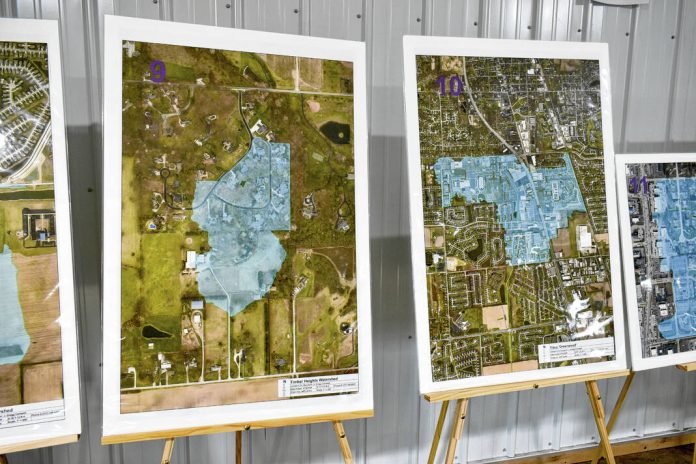A Johnson County board again delayed the approval of reassessment rates for the Tracy Greenwood watershed Tuesday night, the last of the 48 watersheds being reassessed.
The five-member county drainage board unanimously voted to direct Johnson County Surveyor Gregg Cantwell to negotiate with the city of Greenwood regarding the watershed, which is centered roughly in the area of U.S. 31 and Smith Valley Road in Greenwood. Normally, the Johnson County Surveyor’s Office is responsible for the maintenance of legal drains, per state law, but maintenance of this legal drain was turned over several years ago to the city of Greenwood.
However, the county still does the assessment fee for it per state law. The funds are given to the city for the maintenance by the county, Cantwell said last month.
Watersheds are areas of land that contribute, drains or “shed” water into a specific body of water, like a creek or ditch. Every body of water has a watershed it receives water from, and watersheds drain rainfall and other stormwater events to swales, ponds, ditches streams or creeks. Watersheds can vary in size and include many ways to convey water elsewhere.
Johnson County has nearly 400 miles of regulated drains that serve 48 watersheds with a surface area of over 76,000 acres. These watersheds, which are maintained by the surveyor’s office per state law, are a combination of drainage ways, ponds, storm pipes, creeks, ditches and sub-surface tiles. All properties that connect to a legal drain pay an assessment fee for maintenance of the drain.
Rates for the Tracy Greenwood watershed had been up for a vote during the watershed reassessment public hearings held on June 22, but board members tabled it following questions about the accounting of funds used for its maintenance. Members of the Johnson County Drainage Board were not aware that the maintenance had been turned over to Greenwood, they said, because the decision to do this predated them. Johnson County Commissioner Kevin Walls, who is a member of the board, had questions about who was monitoring how much the city spent on maintenance of the drain and whether it was being spent for that purpose, he said last month. They tabled the vote on the reassessment to get more information.
Tuesday night, the Tracy Greenwood reassessment came up again following the continuance. Walls felt that things should be negotiated with Greenwood before the board made their decision. Board members ultimately agreed, directing Cantwell to work with the city.
“There’s multiple different ways that can go and I think we’ll let Greg negotiate that out with the powers to be in Greenwood,” Walls said. “Before anything’s signed, I would like that brought back to the board and we can review that, and we will either fully adopt or reject it at that time.”
Continuing the decision on the reassessment for the Tracy Greenwood watershed will not affect the other 47 watersheds that had their new reassessment rates approved last month. The approval of these rates is the third step in a years-long process to update the county’s watershed maps and drainage assessments which had not been updated in nearly 40 years.
Because of the rapid growth of the county since the 1980s, many properties that connect to the legal drains were not paying accurate rates, or anything at all. Additionally, Many of the tiles and ditches date back to the county’s founding in 1823 when the east side of the county was described as a swamp. Early settlers dug the ditches and plowed the land and the ditches were designed for farming, so many are not built for current developments or modern standards.
Before, rates were being assessed at a flat rate in each watershed, regardless of land use — agricultural, residential, commercial and industrial. Now, the rates will be more varied.
Many of these tiles and ditches also need maintenance work that costs more than what their assessment funds have in the bank. The new rates will help pay for that, Cantwell said.
The assessments are specifically only for the maintenance of the regulated drains, meaning they can’t be used for buying equipment or vehicles, hiring new staff or paying salaries, he said.
For the new rates, officials divided them based on the land use of a property — agricultural, commercial, industrial, residential and exempt. They also worked to make it so heavier uses, like industrial and commercial, would bear more of the costs as they have more impervious surface areas, like parking lots, where water can’t drain as easily.
The new rates vary based on the watershed a property resides within, with some properties not paying the rate at all since they don’t live within a watershed. Those who do live within a watershed will see the rates on their spring property tax assessments next year, officials previously said.





